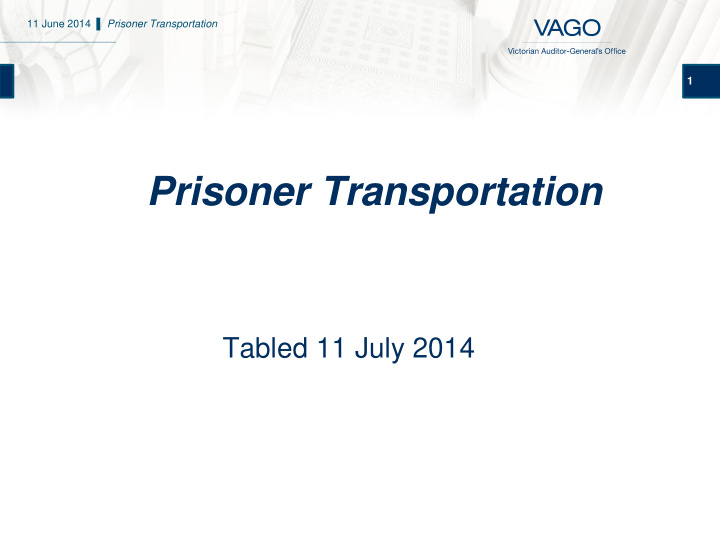



11 June 2014 ▌ Prisoner Transportation 1 Prisoner Transportation Tabled 11 July 2014
11 June 2014 ▌ Prisoner Transportation Background 2 pages • There were 5 892 prisoners in 3–5 February 2014. • Prisoners are moved between prisons, police cells, courts and hospitals. • They are moved by different parties including a prisoner transport contractor. • The prisoner transport contractor responded to 58 000 movement requests in 2012–13. • The prisoner transport contract is worth $42 million over five years. Barwon Prison. Photo courtesy of Corrections Victoria.
11 June 2014 ▌ Prisoner Transportation Audit objective and scope 3 page To examine whether the transportation of 7 prisoners in the criminal justice system is effective, efficient and economical. We looked at whether: • prisoner transportation services are being provided when and where required • prisoners receive appropriate care while in the custody of the contractor • transportation costs are assessed, monitored and minimised.
11 June 2014 ▌ Prisoner Transportation Audit objective and scope – continued 4 page We also looked at whether: 7 • contractual arrangements provide flexibility to match demand and incentives to minimise costs • transportation delays and issues are identified, reviewed and addressed • there is an appropriate performance framework to support delivery outcomes and mitigate risks. The audit included: • Department of Justice • Victoria Police • Department of Human Services.
11 June 2014 ▌ Prisoner Transportation Conclusions 5 pages • No overarching and ix–x coordinated oversight of prisoner transportation. • Inadequate data collected on the total number of prisoner movements and cost of transportation. • Effectiveness and efficiency of prisoner transportation is affected by prisoner capacity constraints. County Court, Melbourne.
11 June 2014 ▌ Prisoner Transportation Findings – no overarching oversight of the system 6 page • Governance and risk x management systems do not cover the full movement of prisoners in the justice system. • There is a lack of interconnectedness between the police and corrections information systems. • Reduces data available to each agency e.g. individual risk assessments. Beechworth Correctional Centre (top) and Langi Kal Kal Prison (bottom). Photo courtesy of Corrections Victoria.
11 June 2014 ▌ Prisoner Transportation Findings – full costs of transportation not known 7 page • The full cost of transporting x prisoners is not known. • The costs associated with Victoria Police movements are not known. • Corrections Victoria and Victoria Police cannot determine the efficiency or value for money of current arrangements. Melbourne Remand Centre. Photo courtesy of the Department of Justice.
11 June 2014 ▌ Prisoner Transportation Findings – arrangements do not drive efficiencies 8 page • Prisoners are not always xi delivered when and where required. • Performance-linked contractor payments do not drive efficiency or effectiveness. Dame Phyllis Frost Centre. Photo courtesy of Corrections Victoria.
11 June 2014 ▌ Prisoner Transportation Findings – manual scheduling is inefficient 9 page Around 50 per cent of prisoner xi movements are scheduled manually. • This creates increased workload. Manual scheduling: • delays transportation • increases the risk of inefficient scheduling • increases the risk of inappropriate separation. Tarrengower Prison (top) and Marngoneet Correctional Centre (bottom). Photos courtesy of Corrections Victoria.
11 June 2014 ▌ Prisoner Transportation Findings – prisoner care can be compromised 10 page • The prisoner transport xi contractor has failed to adequately separate prisoners 21 times since 2009, despite the state having zero tolerance for this. • Prisoners can be moved multiple times between police cells and between police and corrections. Supreme Court, Melbourne. Photo courtesy of Niar/Shutterstock.
11 June 2014 ▌ Prisoner Transportation Findings – positive initiatives 11 page • Dedicated unit xii established to support prisoner movement. • Increased use of telecourt facilities. • New contract payment model being developed. Port Phillip Prison. . Photo courtesy of Corrections Victoria.
11 June 2014 ▌ Prisoner Transportation Recommendations 12 Accept That Corrections Victoria and Victoria Police: 1. develop information and communications technology systems to support greater coordination and capacity utilisation of prisoner transport undertaken by different stakeholders 2. examine the use of different types of prisoner transportation and the costs and risks across the full spectrum of the prisoner transportation system to determine the value for money of current contractual arrangements.
11 June 2014 ▌ Prisoner Transportation Recommendations – continued 13 Accept That Corrections Victoria: 3. identifies performance incentives that are likely to drive more efficient and effective service delivery 4. works with the prisoner transport contractor to ensure that controls supporting the separation and timely delivery of prisoners are adequate and working effectively 5. investigates options for improving efficiency by fully automating the scheduling of prisoner transport in new contractual arrangements.
11 June 2014 ▌ Prisoner Transportation Relevant audits 14 • Prevention and Management of Drug Use in Prisons, October 2013 • Prison Capacity Planning , November 2012 • Management of Prison Accommodation Using Public Private Partnerships , September 2010
11 June 2014 ▌ Prisoner Transportation Contact details 15 For further information on this presentation please contact: Victorian Auditor-General’s Office [p] 8601 7000 [w] www.audit.vic.gov.au/about_us/contact_us.aspx
Recommend
More recommend